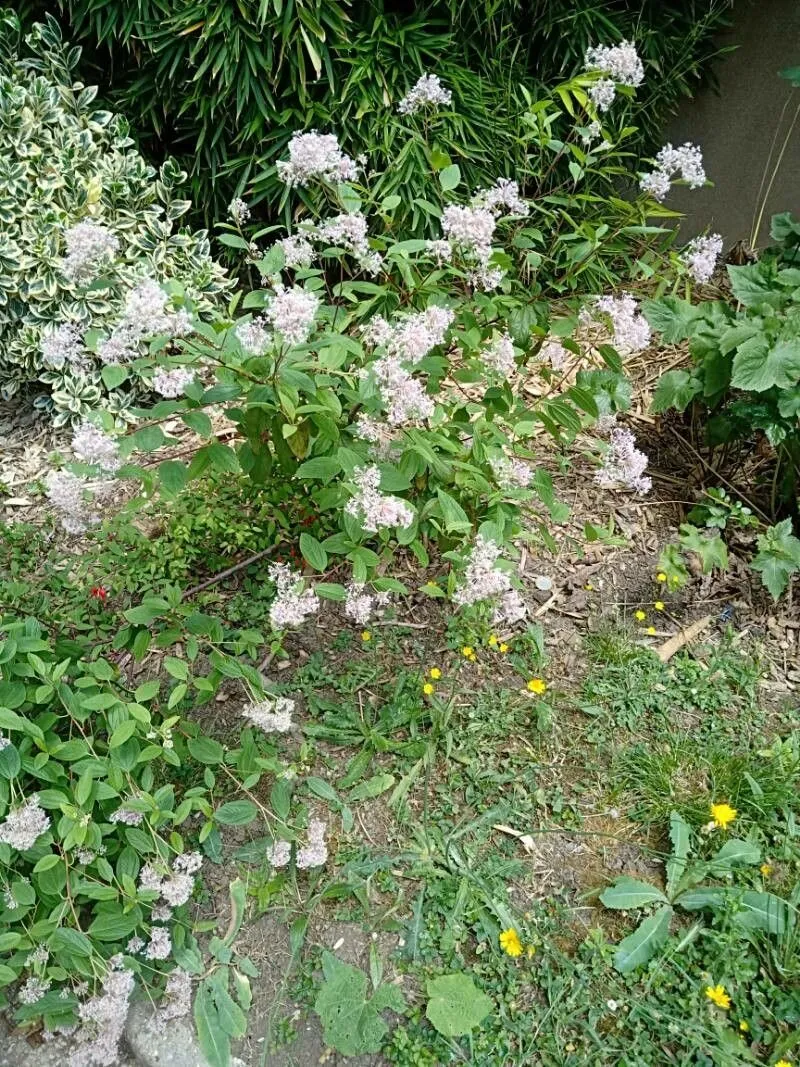
Author: L.
Bibliography: Sp. Pl.: 195 (1753)
Year: 1753
Status: accepted
Rank: species
Genus: Ceanothus
Vegetable: False
Observations: SE. Canada to C. & E. U.S.A.
The New Jersey-tea, scientifically known as Ceanothus americanus, is a remarkable species belonging to the family Rhamnaceae. This resilient and versatile shrub has been admired and used since its discovery and description by the botanist Carl Linnaeus in 1753.
Native to the diverse regions of Southeastern Canada and the Central to Eastern United States, New Jersey-tea thrives in a variety of environments, highlighting its adaptability. It prefers dry, sandy, or rocky soils, often found in prairies, open woodlands, and along roadsides.
New Jersey-tea is easily identified by its distinct characteristics. It is a modestly sized deciduous shrub, typically growing between three to four feet in height. The leaves are simple, ovate, and finely serrated, adorned with a rich green color that makes the shrub an attractive addition to natural landscapes and gardens alike.
One of the most striking features of New Jersey-tea is its delicate clusters of small, fragrant white flowers, which bloom in late spring to early summer. These flowers are not only visually appealing but also serve as a vital nectar source for various pollinators, including butterflies and bees, contributing to the ecological health of its native regions.
Moreover, New Jersey-tea holds historical significance due to its use during the American Revolutionary War. The leaves of the plant were used as a substitute for imported tea, which was scarce at the time, giving rise to its common name. Although it lacks caffeine, the dried leaves of New Jersey-tea were brewed to make a refreshing herbal tea.
In addition to its ornamental and historical value, Ceanothus americanus plays an important role in the restoration of native habitats. Its ability to fix nitrogen in the soil enriches the surrounding environment, promoting the growth of other plant species and fostering a biodiverse ecosystem.
Overall, New Jersey-tea is a plant of great ecological, historical, and aesthetic value. Its resilience and adaptability make it a valuable species for conservation efforts, as well as a charming addition to any garden aiming to replicate the natural beauty of North American flora.
Eng: jersey tea, jersey-tea ceanothus, mountainsweet, new jersey tea, new jersey-tea, redroot, wild snowball
Fra: céanothe d’amérique, céanothus d’amérique
Swe: vit säckbuske
En: New Jersey-tea, Mountainsweet, Redroot, Jersey-tea ceanothus, Wild snowball, New Jersey tea, JERSEY TEA, Jerseytea
Zh: 美洲茶
Fi: Vitituoksio
Fr: Céanothe d’Amérique, Céanothus d’Amérique
It: Ceanothus
No: Taskeblom
Sv: Vit säckbuske
Zh-tw: 美洲茶
Taken Aug 26, 2022 by astrobio . exe (cc-by-sa)
Taken Jun 12, 2022 by Jules Louail (cc-by-sa)
Taken Mar 13, 2022 by yuriko yano (cc-by-sa)
Taken Jul 2, 2021 by Mickael (cc-by-sa)
Taken May 30, 2021 by olivia tumson (cc-by-sa)
Taken Jul 26, 2022 by Tristan Jaton-Maria (cc-by-sa)
Taken Nov 11, 2021 by Willem Defieuw (cc-by-sa)
Taken Jul 27, 2019 by diana_to_sc (cc-by-sa)
Taken Jul 2, 2021 by Mickael (cc-by-sa)
Taken Jun 9, 2022 by René D. (cc-by-sa)
Taken Jun 27, 2022 by matthieu robert (cc-by-sa)
Taken Jan 1, 1900 by EOL − Kristen Van Neste (cc-by-nc-sa)
Taken Jul 26, 2022 by Tristan Jaton-Maria (cc-by-sa)
Taken Jul 26, 2022 by Tristan Jaton-Maria (cc-by-sa)
Taken Nov 11, 2021 by Willem Defieuw (cc-by-sa)
Taken Jun 18, 2021 by Roy Forget (cc-by-sa)
Taken Jun 21, 2007 by EOL − Ron Thomas (cc-by-nc-sa)
Taken Aug 20, 2015 by EOL − Matt Flower (cc-by-nc)
Taken Jul 2, 2015 by EOL − Jesse Lincoln (cc-by-nc)
Taken May 25, 2022 by Maxime Maxime Richard (cc-by-sa)
Taken Jun 8, 2022 by Fabrice Rubio (cc-by-sa)
Taken Aug 8, 2020 by Dan d’Auge (cc-by-sa)
Taken Jul 10, 2021 by Maximilian Palm (cc-by-sa)
Taken Jan 1, 1900 by EOL − Gerrit Davidse (cc-by-nc-sa)
Taken May 29, 2011 by EOL − Ron Thomas (cc-by-nc-sa)
Taken Sep 11, 2004 by EOL − Steven J. Baskauf (cc-by-nc-sa)
© copyright of the Board of Trustees of the Royal Botanic Gardens, Kew.
© copyright of the Board of Trustees of the Royal Botanic Gardens, Kew.
© copyright of the Board of Trustees of the Royal Botanic Gardens, Kew.
Growth form: Multiple Stem
Growth habit: Shrub
Growth rate: Slow
Ph maximum: 8.0
Ph minimum: 6.5
Family: Myrtaceae Author: (F.Muell.) K.D.Hill & L.A.S.Johnson Bibliography: Telopea 6: 402 (1995) Year: 1995 Status:…
Family: Rubiaceae Author: Pierre ex A.Froehner Bibliography: Notizbl. Bot. Gart. Berlin-Dahlem 1: 237 (1897) Year:…
Family: Sapindaceae Author: Koidz. Bibliography: J. Coll. Sci. Imp. Univ. Tokyo 32(1): 38 (1911) Year:…
Family: Asteraceae Author: A.Gray Bibliography: Pacif. Railr. Rep.: 107 (1857) Year: 1857 Status: accepted Rank:…
Family: Fabaceae Author: Medik. Bibliography: Vorles. Churpfälz. Phys.-Ökon. Ges. 2: 398 (1787) Year: 1787 Status:…
Family: Aspleniaceae Author: (Cav.) Alston Bibliography: Bull. Misc. Inform. Kew 1932: 309 (1932) Year: 1932…